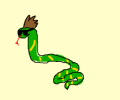» Site Navigation

0 members and 616 guests
No Members online
Most users ever online was 47,180, 07-16-2025 at 05:30 PM.
» Today's Birthdays

» Stats

Members: 75,905
Threads: 249,105
Posts: 2,572,114
Top Poster: JLC (31,651)
|
-
Registered User


 Re: Proposed Ball Python Feeding Chart Re: Proposed Ball Python Feeding Chart
 Originally Posted by sorraia

I am a scientist, a biologist to be precise. And I see a major flaw in the OP's chart:
OP is assuming all sizes and all developmental stages require the same nutritional intake.
This is in fact false. Nutritional requirements change as an animal grows and develops. This is true of all animals.
In a nut shell, and keeping it simple in terms of "calories" only (ignoring all other nutrients, though other nutrients are important too):
All living animals require a certain base level of calories to maintain basic bodily functions. These bodily functions include respiration, blood circulation, and digestion, and in the case of warm-blooded animals also includes calories required to produce heat (some of which occurs as a result of activity and basic bodily functions).
Growing animals have a higher caloric requirement. In order to sustain basic bodily functions as well as growth, more calories must be consumed. Therefore a growing animal must consume a greater number of calories proportional to its size than a full grown animal. This is where the OP's chart falls apart. The OP is assuming the same 10% of body weight in food is required by a hatchling as a full grown 2000+g adult. This is not true.
Females who are reproducing also have a higher caloric requirement, though not necessarily as high as a young growing animal. Females produce offspring, some of their calories are allotted to this creation of new bodies (whether those bodies be in the form of eggs or in the form of live young gestated inside the mother's body). In order to meet this caloric demand and still maintain her basic bodily functions, a female must consume a slightly higher calorie value than a non-reproducing female. Males are excluded from this and treated as "non-reproducing females" because the production of sperm takes considerably less energy than the production of eggs or young. (For mammals, caloric requirement remains high post-partem during the lactation period. Lactation requires more calories to maintain.)
So what does all of this mean?
This means, you can follow the "10% rule" (or rather, 10-15% that is generally recommended) as long as the animal is growing. However once growth slows or ceases, it will be necessary to pull back and feed less than 10-15% of the animal's body weight. How much exactly will depend on a few factors, such as the animal's overall size and reproductive status. In order to determine a hard number, there needs to be well planned and executed study. I don't know if any one has done this, but in a less-stringent format experienced hobbyists HAVE figured it out. That's where experience is important. Science and experience need not be opposites nor combatants, but can work together. The reason we no longer practice blood letting or make dinner the biggest meal of the day (actually some people still do) is not strictly because science has told us it doesn't work, but also because experience has told us it doesn't work. In fact, often the experience (Why isn't this working?) prompts the scientific study that tells us the why.
I completely agree with you. My chart certainly does neglect the fact that some animals will grow at different rates than others. What my chart does look at is an average. No one can plan anything though not having any idea what size critters their snake will eat (and the standard deviation of a ball pythons weight is not extremely far from the average), so at least it is good to have a chart to know about what to buy for them. I did not make any points about females requiring more nutritional value as Dave Munson's chart does intentionally because this chart does not account for extenuating circumstances. It is merely meant to be a simple feeding chart because I could not find one better. Again I stress, if anyone knows of a better feeding chart with more information please provide it. That is the whole point of this discussion. Even the care sheet on these forums here still only lists the "feed your snake about it's girth, but no more than that" rule of thumb and says this issue is still up for debate. Well I am debating that what I have presented here is additional guidance to that rule of thumb and that it does help people that need to plan ahead for what they are going to feed. There are a lot of things to the growing process of ball pythons that don't make much sense to me. For example, I fed my female a 19 gram mouse the other week and when I weighed her this week she was over 25 grams larger. Where she is getting that extra weight from, I have no idea. Again though, I agree with everything you said and it is great input on the topic. Thank you for your contribution!
-
 Posting Permissions
Posting Permissions
- You may not post new threads
- You may not post replies
- You may not post attachments
- You may not edit your posts
-
Forum Rules
|










